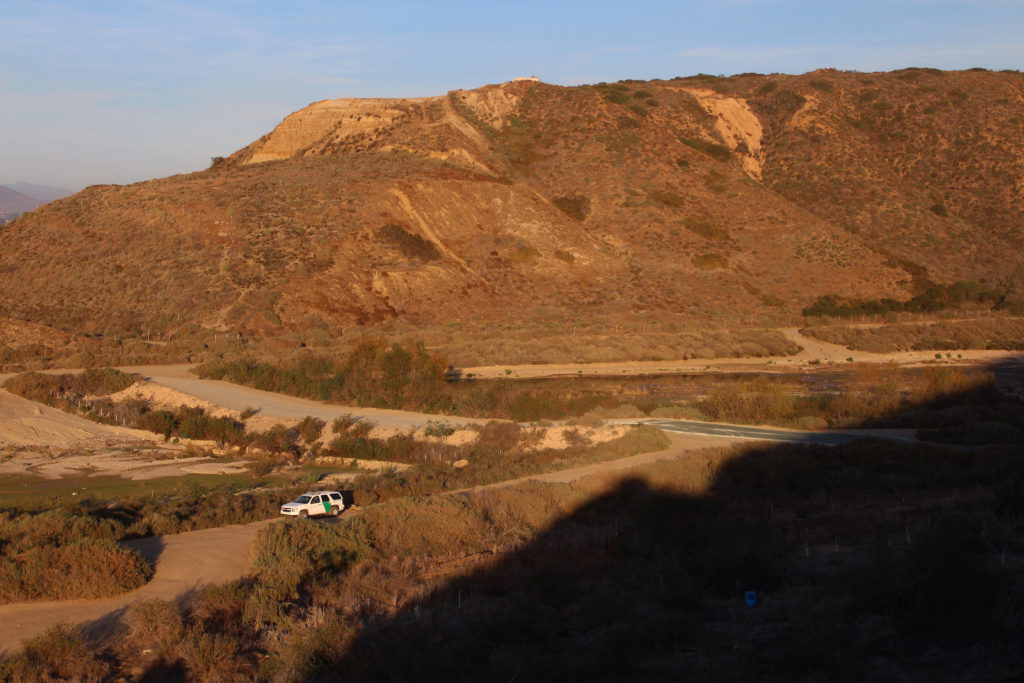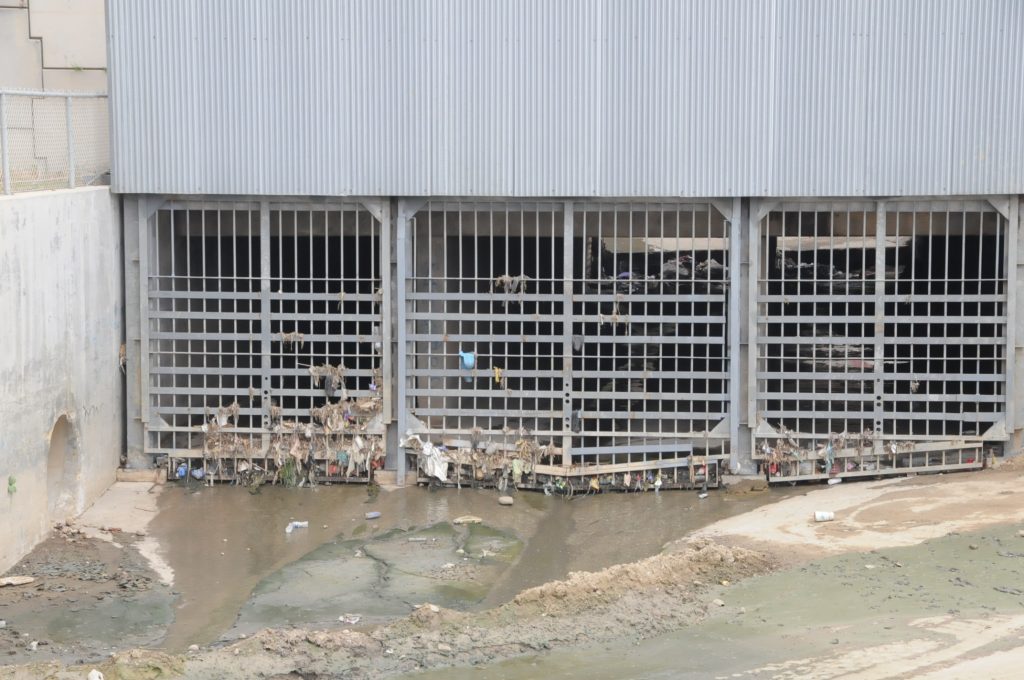Written By , Voice of San Diego, April 17, 2023

Republished per content sharing policy
The 1980 flood in the Tijuana River Valley was one of its worst.
Rains filled nearby reservoirs so much that water had to be released into the already-raging Tijuana River. If a wall stood in the river then, like the one Customs and Border Protection is building right now, it would be met with water speeds and force equivalent to 175 fully-loaded shipping containers hitting the barrier every second, according to Jochen Schubert, a flood risk expert at University of California-Irvine.

Such force could potentially break the series of sliding gates Border Patrol plans to raise or lower during rains. Or worse, the mere presence of structures in the river could slow down such a force of water enough to cause it to back up into Tijuana, a city often mired by flooding.

A 100-year flood event would be at least twice as bad as the 1980 one. The term means there’s a one percent chance every year floodwaters could grow that intense, which would look like 350 fully loaded shipping containers-worth of water hitting a future border wall every second.
To deal with that much force hitting the wall, Jean Prijatel, an environmental review manager for the Environmental Protection, strongly recommended the Border Patrol add safety measures allowing pieces of the proposed gated wall across the river to break away should they fail to open during flood situations, in a September 2020 letter to the agency.

Prijatel wrote Border Patrol again in July of 2022 after it became clear to her that the project was moving forward rapidly without doing the kinds of studies the EPA felt were necessary to avoid harm.
“We have significant concerns regarding the risk of catastrophic flooding should the lift gate system not operate as planned, potentially leading to severe property damage, damage to infrastructure and the loss of life or injury to people,” Prijatel wrote.
Publicly, the EPA has said little about U.S. Homeland Security’s effort to “close a gap” in the border wall with a 30-foot tall bridge and liftable steel gate system across the river channel. But the two federal agencies have been at odds over the project since it was first announced in August of 2020, according to documents provided to Voice of San Diego through a Freedom of Information Act request.

In January, as the State Department was preparing a formal response to Mexico’s inquiries about the project, the EPA’s Region 9 office which covers the Pacific Southwest revealed it disagreed with Border Patrol’s claim that the two agencies had been closely working together on the design, construction and operation of the gated wall.
“CBP’s own analysis … indicates that river levels will rise a few feet due to flow obstruction from the piers of the bridge,” the EPA wrote in its comments to the State Department. “Any elevation increases in the river are likely to exacerbate flooding in low-lying streets in Tijuana that drain to the river.”
Much of Tijuana’s downtown core are low-lying streets that hug the river channel which often collects raw sewage and trash before flowing into the U.S. At the border line, the concrete channel turns into a natural riverbed, where border agents stand guard and sometimes enter the river to apprehend people attempting to cross. The Border Patrol announced it had rescued a group of Haitians stranded in the river channel in an attempt to cross in March. It’s also where a group of Central Americans attempted to run into the U.S. in 2018 before agents fired tear gas canisters into the crowd.
Border Patrol spokesperson Gerrelaine Alcordo told Voice of San Diego in January that the Tijuana River “is a current health and safety concern for agents and migrants due to the heavily polluted conditions of the river channel.” The Border Patrol started preliminary construction in November, but recent rains have stalled major construction.

The EPA is waiting for Border Patrol to prove the wall won’t exacerbate flooding. The agency is responsible for ensuring other federal agencies comply with the National Environmental Policy Act. But Border Patrol projects like this one can skip federally required environmental studies under a waiver granted by Congress.
The EPA letters warn that a number of other things could also go wrong.
Trash and debris could pile against the closed gates, causing water to dam up behind it and breach Tijuana’s levees, the agency said.

The bridge gates could fail to open altogether during a storm, which could slow down the flow of the river enough to cause catastrophic flooding on both sides of the border, the EPA wrote. Gates like these have failed before.
The Border Patrol is responsible for opening large steel gates over drains built through canyons that divide San Diego and Tijuana. The EPA cited that in November of 2019, one of those gates failed to fully open and the accumulation of a huge amount of trash caused flooding at two Tijuana wastewater pumps. While those pumps were being repaired, raw sewage that would otherwise have been treated flowed instead into the Tijuana River and subsequently the Pacific Ocean, closing beaches along the southern California coast.
The EPA cited border gates failures elsewhere in the U.S. A gate in Arizona’s Oregon Pipe Cactus National Monument didn’t open during a storm in 2011, and water eventually blew out a 40-foot section of gate which washed downstream. And in 2014 gates didn’t rise along Douglas, Arizona’s Silver Creek, which caused floods to sweep away a section of fence and affected homes in 2021.
Despite Border Patrol’s Congressional environmental review waiver, the agency conducted some hydrologic studies to predict the wall’s impact on extreme flooding under what’s called a 100-year flood scenario, the EPA wrote. But Border Patrol didn’t look at the project’s impact during future, more intense flooding expected as the climate changes, like a 500-year flood scenario, Prijatel wrote.
Alcordo said in January that the gates are designed to open manually should the automatic method fail. The IBWC, which manages an international wastewater treatment plant in San Diego, would conduct regular maintenance and clear debris from behind the gates.
But San Diego politicians are worried the new border wall would negatively impact $330 million worth of federally funded sewage control projects sought by Southern California communities that regularly experience beach closures due to Tijuana River contamination.
“It’s extremely concerning because of the uncertainty of our weather patterns and what scientists have predicted will be less frequent but more intense storm events,” said Paloma Aguirre, mayor of Imperial Beach where coastlines are frequently closed by cross-border contamination. “We don’t have enough models or information from CBP.”
Mexico, too, is worried about enhanced flood risks the project poses for Tijuana, which experienced this year some of the heaviest rains and worst flooding in decades.
“There is concern, of course, about the possible flooding that this U.S. infrastructure project could entail,” Carlos González Gutiérrez, the consul general of Mexico, said in a statement. He said the Mexican division of an international agency charged with negotiating water issues has raised these concerns to its U.S. counterpart, the International Boundary and Water Commission.
The northerly Tijuana River begins on the U.S. side of the border before snaking through Tijuana and emptying into San Diego. This winter, heavy rains caused major flooding in the border community of San Ysidro.
San Diego Assemblyman David Alvarez expressed opposition to the border wall project in a Feb. 1 letter to Border Patrol obtained through the Freedom of Information Act request.
“Until these hydrology impacts can be fully analyzed… constructing these new border barriers are a waste of American taxpayer dollars and not a real policy solution,” Alvarez wrote.
 Written By MacKenzie Elmer
Written By MacKenzie Elmer
MacKenzie is a reporter for Voice of San Diego who writes about the environment and natural resources.
This story was first published by Voice of San Diego. Sign up for VOSD’s newsletters here.
RELATED ARTICLES




